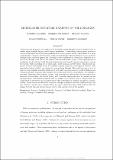| dc.contributor.author | Casarin, Roberto | |
| dc.contributor.author | Iacopini, Matteo | |
| dc.contributor.author | Molina, German | |
| dc.contributor.author | ter Horst, Enrique | |
| dc.contributor.author | Espinasa, Ramon | |
| dc.contributor.author | Sucre, Carlos | |
| dc.contributor.author | Rigobon, Roberto | |
| dc.date.accessioned | 2021-04-22T15:55:43Z | |
| dc.date.available | 2021-04-22T15:55:43Z | |
| dc.date.issued | 2020-01 | |
| dc.date.submitted | 2019-01 | |
| dc.identifier.issn | 1368-4221 | |
| dc.identifier.issn | 1368-423X | |
| dc.identifier.uri | https://hdl.handle.net/1721.1/130503 | |
| dc.description.abstract | This manuscript proposes a new approach for unveiling existing linkages within the international oil market across multiple driving factors beyond production. A multilayer, multicountry network is extracted through a novel Bayesian graphical vector autoregressive model, which allows for a more comprehensive, dynamic representation of the network linkages than do traditional or static pairwise Granger-causal inference approaches. Building on previous work, the layers of the network include country-and region-specific oil production levels and rigs, both through simultaneous and lagged temporal dependences among key factors, while controlling for oil prices and a world economic activity index. The proposed approach extracts relationships across all variables through a dynamic, cross-regional network. This approach is highly scalable and adjusts for time-evolving linkages. The model outcome is a set of time-varying graphical networks that unveil both static representations of world oil linkages and variations in microeconomic relationships both within and between oil producers. An example is provided, illustrating the evolution of intra-and inter-regional relationships for two major interconnected oil producers: the United States, with a regional decomposition of its production and rig deployment, and the Arabian Peninsula and key Middle Eastern producers, with a country-based decomposition of production and rig deployment, while controlling for oil prices and global economic indices. Production is less affected by concurrent changes in oil prices and the overall economy than rigs. However, production is a lagged driver for prices, rather than rigs, which indicates that the linkage between rigs and production may not be fully accounted for in the markets. | en_US |
| dc.language.iso | en | |
| dc.publisher | Oxford University Press (OUP) | en_US |
| dc.relation.isversionof | http://dx.doi.org/10.1093/ectj/utaa003 | en_US |
| dc.rights | Creative Commons Attribution-Noncommercial-Share Alike | en_US |
| dc.rights.uri | http://creativecommons.org/licenses/by-nc-sa/4.0/ | en_US |
| dc.source | SSRN | en_US |
| dc.title | Multilayer network analysis of oil linkages | en_US |
| dc.type | Article | en_US |
| dc.identifier.citation | Casarin, Roberto et al. "Multilayer network analysis of oil linkages." Econometrics Journal 23, 2 (January 2020): 269–296. © 2020 Royal Economic Society | en_US |
| dc.contributor.department | Sloan School of Management | |
| dc.relation.journal | Econometrics Journal | en_US |
| dc.eprint.version | Original manuscript | en_US |
| dc.type.uri | http://purl.org/eprint/type/JournalArticle | en_US |
| eprint.status | http://purl.org/eprint/status/NonPeerReviewed | en_US |
| dc.date.updated | 2021-04-06T17:07:17Z | |
| dspace.orderedauthors | Casarin, R; Iacopini, M; Molina, G; ter Horst, E; Espinasa, R; Sucre, C; Rigobon, R | en_US |
| dspace.date.submission | 2021-04-06T17:07:18Z | |
| mit.journal.volume | 23 | en_US |
| mit.journal.issue | 2 | en_US |
| mit.license | OPEN_ACCESS_POLICY | |
| mit.metadata.status | Authority Work and Publication Information Needed | |
